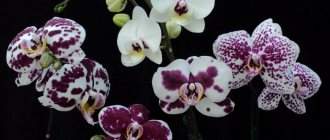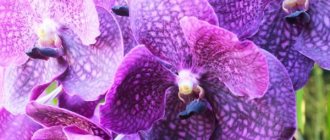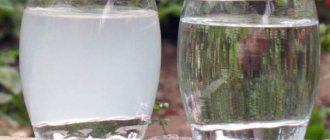Basic rules of watering
Water the flower when the substrate in the pot begins to dry out. The intensity of watering will depend on many nuances: room temperature, humidity, sunlight, period of life, and much more.
Since in its natural environment the orchid is nourished by rain, it is advisable for flower growers to use water whose composition will be close to that of rain. The water should be at room temperature, and in no case hard . Tap water almost always needs to be softened. For these purposes, you can use special oxalic acid, which is sold in every flower shop and is used to soften water. A day before the intended watering, you need to make a solution (for 5 liters of water you will need 1/8 tsp of oxalic acid). Immediately before irrigation, the water is drained from the sediment and then filtered.
Tropical flowers are watered in the morning so that during the day the water evaporates from the axils of the leaves. Water for irrigation must be saturated with oxygen. To do this, immediately before watering, it should be poured several times from one container to another.
Comfortable temperature
Despite the fact that all orchids sold in stores are adapted to room temperatures of +18...+25 degrees, lately summer has become a little hotter and temperatures can reach up to +35 degrees.
If such temperature increases are short-term, then the plants will be able to survive them without consequences. Prolonged heat can significantly weaken the plant’s immunity, which will lead to stunted growth or even disease of the orchid.
You can create a comfortable environment by frequently ventilating the room; it is best to do this at night. Using an air conditioner will also have a good effect on the well-being of plants, provided that they are located far from the flow of cold air.
How often can you water orchids?
How often to water an orchid at home? There is no specific answer to this question. The frequency of watering depends on the temperature and humidity in the room where the orchid grows, on the type of substrate in the pot, as well as on the time of year. During the rest period after flowering, the plant does not require frequent watering; this fact should also be taken into account when choosing the frequency of watering. An orchid will feel good if you create conditions similar to those in which it grows in the wild.
How to determine what frequency of watering to choose. Florists recommend the following techniques:
- Watering orchids should be postponed if you notice droplets of condensation on the walls of the flower pot.
- Since the root system of orchids is on the surface, the condition of the roots can determine whether the plant needs watering. The bright green roots indicate that the flower does not need to be watered. If the roots become light, watering is required.
- You can lift a flower pot and determine by its weight whether the orchid needs water. A heavy flower pot indicates that watering is not needed yet. If the pot becomes light, be sure to water the orchid.
- Flower growers check the substrate with their fingers. If it is dry, the plant is watered.
- You can check the moisture content of the substrate with a toothpick, similar to a cake in the oven. Any housewife knows how to check the readiness of the pie: poke holes with a toothpick, after which the toothpick is removed. If it is dry, the pie is ready; if there are pieces of dough stuck to it, the pie is left to finish baking. Pierce the substrate with a toothpick. If particles of the substrate stick to the wooden stick, it is too early to water the flower.
- If you notice that the soil in which the orchid grows has become lighter, this means that the flower needs watering.
The frequency of watering also depends on the type of flower. When purchasing an orchid, ask what kind of watering is needed for this type of plant. As a rule, orchids are watered 1-3 times a week in the summer, and only a few times a month in the winter.
Humidity and spraying
In their natural environment, orchids are found in conditions of high humidity. Therefore, in an apartment, the optimal level for them is close to natural. The indicator should be from 60% to 80%. If it is lower, you can use several methods to increase the humidity:
- orchids love a mist of their spray bottle. But the procedure must be carried out as competently as possible. Novice gardeners make the mistake of spraying the plant very often. As a result, it does not have time to dry completely, water accumulates and provokes rotting. The problem is that this is not noticeable from the very beginning. Gradually the leaves turn yellow and fall off completely. Spraying can be carried out only before lunch in spring and summer. During the cold season, the procedure is not recommended;
- In winter, during the heating season, dishes with water are placed near the radiator. Gradually, the liquid begins to evaporate, providing an optimal level of humidity in the air;
- You can place vases or cups of water near the plant.
Is it possible to spray geraniums with water and how to water them correctly
The best way to raise the required level of humidity in a room is to use a humidifier.
Note! Dry air in an apartment is detrimental to orchids. It provokes the appearance and active reproduction of pests.
Spraying the flower can be done in hot summer and spring
What kind of water is suitable
Much depends on what kind of water is used to water tropical flowers. In the wild, orchids are watered by rain, but in our ecology, rainwater can contain a whole range of different chemical components, so it is better not to use it for watering.
The water you use to water the plants should be soft. There are many ways to determine the degree of water hardness. One of the indicators that hard water is flowing from the tap is that scale forms in the kettle very quickly.
You can buy special tests to determine the degree of water hardness, which will accurately determine how hard your tap water is. Before watering flowers, hard water should be softened.
Water softening methods
- Oxalic acid, which is diluted in water and left for a day. After this, the water must be carefully drained, being careful not to touch the sediment.
- A canvas bag filled with high-moor peat is left in the water for irrigation. Before watering, the bag is removed from the container. This method will not only soften, but also acidify the water.
- Before watering, the water is passed through a household purification filter several times.
- Quite often, experienced flower growers use boiled water at room temperature to water their flowers. When boiling, all harmful microbes are killed, chlorine is eliminated, and heavy salts precipitate.
- To improve the condition of the water used for irrigation, many add garlic, succinic acid, and potassium permanganate. Garlic water helps improve the flowering of orchids, and at the same time disinfects the plant. Amber water increases the plant’s immunity, helping the orchid to better resist various diseases. A weak solution of potassium permanganate helps disinfect the roots.
Novice gardeners make the mistake of using distilled water for watering. It is strictly forbidden to water an orchid with purified water! Distilled water is used for washing leaves, roots, irrigation, and also for diluting fertilizers.
The water temperature for irrigation should vary between 30-40 degrees. It is also important what acidity the water will have. The ideal pH level is 5.5. Check acidity using litmus paper. If the acidity level of the water is lower, add a few drops of freshly squeezed lemon juice.
Ideal water for orchids
There are certain requirements for water, gross non-compliance with which can negatively affect the condition and health of the orchid. All main characteristics of water for irrigation are given below:
- Hardness is one of the main parameters of water, which is determined by calculating the volumes of calcium and magnesium included in its composition. Many orchids are not too sensitive to changes in water hardness, but some varieties react negatively to deviations from optimal parameters, becoming covered with black ulcers because of this. Many experts believe that the most suitable hardness is in the range of 2 – 7°dH, but in some areas and regions it can be quite problematic to obtain such water. The solution to the problem is to replace the soil used with a special substrate, which consists of approximately 15–20% peat. It must be borne in mind that every 2 - 3 years it will need to be completely replaced.
- Acidity is another indicator on which the health and general condition of grown orchids also depends. First of all, it affects the development and growth of the root system; for most varieties, the optimal value is 5.5 - 6.5 pH, but there are certain plant varieties that feel better at an acidity of 7 - 7.8 pH. It is best to clarify the features and preferences of each specific type with specialists when making a purchase.
- Water temperature also plays a huge role for the healthy growth of such plants; it should be warm enough, the most optimal values are in the range of +30 – +35°C. In some situations, watering with colder water is allowed, but its temperature in any case should not be lower than +18°C, otherwise a deterioration in the condition of the flower may be observed, as well as a decrease in its immunity, which increases the risk of infection with various diseases or damage by parasites and fungi.
Watering methods
Depending on what kind of orchid you have, watering can be of several types:
Hot shower
Watering as close to tropical rain as possible will help the orchid stay healthy, grow faster, and bloom more often. Constant showering is a preventive measure against pests and bacteria. How to give an orchid a shower:
- The orchid pot should be placed in the bath. Using a shower head, turn the pressure to low and spray the plant with warm water. The water temperature should be about 45 degrees.
- As soon as the substrate is completely saturated with water, the orchid should be left in the bathroom for 20-30 minutes so that all excess moisture drains away.
- After this, using a soft, dry napkin or cloth, carefully wipe each leaf and young sprout. If you shower a Vanda or Phalaenopsis orchid, you should wipe the core dry, otherwise the plant may begin to rot.
- Take the pot out of the bathroom and place it in its usual place - if it is a windowsill, you should make sure that the orchid does not get direct sunlight.
Immersion of the plant
A fairly popular and effective method of watering, but it is used only when the orchid is completely healthy. The pot along with the orchid is lowered into pre-prepared water. Pots measuring about 12x12 cm are left in water for half a minute, after which they are kept in the air so that all excess water has time to drain.
Classic watering
Many gardeners are accustomed to watering indoor plants with a special watering can. Orchids can also be watered using a watering can, using very low pressure. Water flows until excess moisture begins to drip from the holes below. Wait until the unnecessary water pours out of the pot, then repeat the procedure. Make sure that the water remaining in the pan is poured out in a timely manner, otherwise the plant may rot.
Irrigation of the root system
In the case when an orchid is grown without a substrate, irrigating the roots is the best method of watering. In a pot with a substrate, the roots do not dry out as much as when growing orchids using blocks. You will need a special flower spray. Set the “Fog” mode and point the spray bottle directly at the roots. Irrigate until the color of the roots begins to change from earthy to green. A repeat procedure will be needed when the roots begin to dry out.
Surface watering
This method uses a watering can, from which the substrate itself is watered with a thin pressure. The water slowly fills the substrate and then evaporates over several days. You need to water until the substrate is completely wet with water. Under no circumstances should you overwater an orchid! Surface watering is considered the most affordable and simple method.
Watering in a tray
Those flower growers who value their time use the method of watering flowers using a tray. The process is very simple and quick: pots with orchids are placed on one large tray, into which you need to pour pre-prepared water. Orchids themselves will take as much water as they need.
How to water orchids when they bloom
How to water orchids that are starting to bloom? As soon as the orchid enters a period of active flowering, the frequency of watering increases to several times a week . The ideal is to water 2-3 times every 7 days . Water the flower early in the morning, under no circumstances allowing the roots to flood. After the flower stalk appears, watering becomes more frequent as the plant needs additional nutrition.
If the orchid blooms in a dry room, it should be watered more often than usual. It is advisable to add irrigation to the leaves, but you should be very careful not to allow water to get on the flowers and buds themselves.
After flowering ends, when the flowers begin to fade, watering is halved. It is necessary to monitor the substrate: by the next watering it should be almost dry.
Outdoor irrigation
The garden orchid loves rain and can be watered in the morning and evening. It is necessary to water regularly, not allowing the soil to dry out. However, overwatering should not be allowed. The garden orchid prefers to be in moderately moist soil. To do this, you also need to ensure good drainage.
On a note. For an orchid growing outdoors, it is better to organize a drip humidification system.
Let's consider the frequency of watering orchids when the plant is blooming and during dormancy:
Watering orchids in winter
In the last months of autumn, the orchid rests in a dormant state. The flower no longer needs such frequent and abundant watering as in summer, during the flowering period. In winter, it is recommended to water orchids no more than once every two weeks .
In winter, the root system of orchids does not absorb water as actively, so the immersion method is considered the most suitable. After immersion, do not forget to allow excess water to drain completely so that the root system does not rot.
It is best to water flowers in the evening in the autumn-winter period. It is better to water in a warm bath, leaving the orchid in it to allow excess water to drain completely. You should not immediately place the flower in a cool room after watering. Sudden changes in temperature do not have the best effect on the condition of orchids.
Features of moisture consumption by orchids
The mode of moisture consumption is influenced by the lifestyle of plants. To create comfortable conditions for the growth of orchids, it is necessary to adapt the process of home watering to the natural conditions under which the plant receives moisture.
Growing orchids in transparent pots
Here are some important features of the process.
- Orchids receive moisture from rain, dew, and fog. The soil dries quickly, so moisture does not stagnate in the root system.
- Plants consume water in small doses. The special structure of the root is noteworthy. Thin hair is covered with corked fabric, which is similar in structure and effect on moisture absorption to a sponge.
- Ability to survive even long periods of drought. Liquid accumulates in the stem, leaves, and other green parts of the plant.
- Cyclic development. When the roots and stems reach the required size, it is time to flower. In their natural habitat, orchids bloom during periods of high rainfall. When growing orchids at home, it is necessary to increase the amount of moisture when the plant blooms.
- The rate of moisture absorption depends on the growth rate. When the plant receives little light, development processes slow down and the orchid goes into a dormant state. At this time, the need for moisture decreases. If you continue to water a plant moved to the shade at the usual frequency, you can provoke root rot and the onset of other diseases.
Root rotting
On a note! To confirm or rule out that the plant is in dormancy mode, it is necessary to evaluate the condition of the roots. If the flower is in an active growth phase, the root is green and a growing point can be found on it. When the flower goes dormant, the root turns white.
How to water immediately after purchase
As you know, replanting orchids immediately after purchase is not recommended. After a change of environment, the plant experiences shock and must be given time to recover so that it gets used to the new place. Typically this will take about two weeks. After transplantation, the orchid immediately needs watering. Experienced flower growers, after the first transplant, place the flower pot in a large container with warm water, and after 20-25 minutes, take the pot out to drain excess liquid. After this, the orchid is placed in a place where it will not receive direct sunlight.
There is no need to water the orchid for two weeks after this. Subsequently, the plant is watered according to the standard scheme, at least several times a week. As a rule, by this time the orchid begins to bloom, and then watering is carried out according to the usual rules.
After transplant
Orchids are replanted not only after purchase, but also after hibernation. It is worth noting that it is better not to use large pots. The more compact the flower pot into which the orchid is transplanted, the better the roots will develop in it. As soon as the flower is transplanted into a new pot with a new substrate, it should be watered immediately. Then the flower pot with the orchid should be placed in a container filled with warm water for 20-25 minutes. After this time, the excess liquid should drain, and then the pot is placed in a darkened room, away from bright sunlight. The next two weeks after transplantation, the orchid does not need watering. The flower experiences stress after transplantation, so it is better not to disturb it. Frequent watering can only worsen the situation, so you should leave the orchid alone for 14 days.
After the orchid adapts to new conditions, it will need additional nutrition, a comfortable place, and good care. You need to water the flower at least twice a week, ideally 2-3 times every 7 days. Orchids are replanted in the summer, before flowering begins, so watering should be more frequent.
What errors may occur
Improper watering can lead to disastrous results, including the death of the plant. What mistakes are made when watering:
- Excess moisture can cause root rot. To avoid this, it is necessary to install foam drainage approximately 4 cm high.
- When watering, water should never get into the axils of the leaves. If this happens, immediately wipe the leaves dry with a soft, clean cloth or napkin.
- Using the spraying method, this should be done at a distance of about 20 cm. Otherwise, large drops will form on the leaves and flowers, which negatively affect the appearance and condition of the plant.
- Water for irrigation must meet all standards. By using hard, too cold or contaminated water, you risk the health and even the life of your orchids.
- Prepare water for irrigation thoroughly in advance. It should be soft, comfortable temperature, with a suitable ph balance.
- It is necessary to water flowers only in the morning, since watering in the sun can cause burns. The optimal time for watering is early morning.
- The immersion method is used only when the orchid and the substrate are not infected with any diseases. Just in case, it is better to change the water after each pot. If the flower is in the incubation period, you will reduce the risk of infecting other orchids.
What water is best to use
The possibility of obtaining water of different types and origins provides flower growers with a certain freedom of choice, but at the same time they are faced with the question of the rationality of making one or another decision, since the quality is not the same for all varieties.
Below are the features of all the main types of water that are most often used for watering orchids:
- Tap water can be used for irrigation only after preliminary settling, since it contains too many different chemical compounds and impurities that can pose a threat to the health of the plant. Also, its use is allowed only if water flows from the water supply with a suitable hardness level, otherwise the flower will not be allowed to carry out procedures such as a hot shower or watering from the tap.
- Tap water, which is first brought to a boil and then cooled to the optimal temperature, is the most common option. The main advantage is the simplicity of this technique; it has no visible disadvantages, since after this procedure the stiffness indicators are normalized.
- Rainwater is a good option for irrigation, but it must be borne in mind that its collection can only be done outside the city, given the current environmental situation. Storage also has a number of limitations, since you need to choose cool places where there is no natural or artificial light, otherwise there is a risk of active growth of bacteria that can destroy the orchid.
- Distilled water can only be used for irrigation in diluted form; for this purpose, the tap variety is used. With average hardness levels, the proportions when mixing will be the same, this will allow you to regulate the volume of salts in the composition. The only drawback is the costs, which directly depend on the number of plants grown.
- Filtered water can be obtained by using a variety of modern devices that allow it to be purified from heavy metals, salts, microorganisms and various harmful impurities. The filtration process is not very expensive, but in some situations it can be very time-consuming.
How to water a dwarf orchid
Dwarf orchids have recently gained active popularity. A small plant with beautiful flowers attracts many gardeners, but dwarf orchids require proper care. The health of the mini-orchid and its flowering depend on how correct the watering is.
How to water an orchid correctly? During the dormant period after flowering (this period occurs in the winter months), the mini-orchid should be watered no more than once every two weeks. In the warm season, when active flowering of all orchids begins, dwarf flowers should be watered once every 3-4 days.
The substrate or moss in the pot does not need to be moistened until the moisture has completely evaporated from it. Mini-orchids, thanks to their dry roots, receive the necessary oxygen, so under no circumstances should they be overfilled with water. The small phalaenopsis orchid loves to be watered by immersion in water. The pot with the mini-orchid is immersed in warm water and kept there for about 20-25 minutes. Dwarf orchids should not be left in water for a long time, otherwise rotting may begin in the root system.
Is it possible to revive a dried orchid?
If watered incorrectly, the orchid begins to dry out, the leaves become yellow and sluggish, and the flowering process does not begin. As soon as you notice the first symptoms, the orchid must be treated immediately. The sooner this is done, the higher the likelihood of a favorable outcome.
You should immediately check the condition of the orchid's root system. Perhaps the roots have dried out too much or, conversely, have begun to rot. During the flower recovery period, it is better to use the method of spraying or immersing the orchid in a tray with warm water.
If an orchid is watered too often, you can get the opposite effect: the flower begins to rot, and fungal diseases may appear. To prevent these problems, it is necessary to moisten the substrate only after it has completely dried. If you water the flowers without waiting for the substrate to dry, you can cause the orchid to become sick or even die.
The size of the flower pot in which the orchid grows is of great importance. The flower feels much better in a smaller pot, especially since in larger flowerpots the substrate takes much longer to dry.
Caring for orchids is not that difficult, but a lot will depend on proper watering. You should study the basic rules for watering and feeding tropical flowers in advance so as not to encounter serious problems in the future. If you water and care for orchids correctly, they will feel great and will delight their owners with excellent, luxurious, incomparable flowering.











